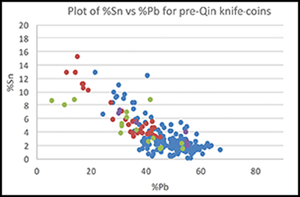Crossref Citations
This article has been cited by the following publications. This list is generated based on data provided by
Crossref.
Zhiyan, Zhang
and
Jianfeng, Cui
2022.
Revisiting the addition of tin and lead in Chinese bronzes: A statistical perspective.
Advances in Archaeomaterials,
Vol. 3,
Issue. 2,
p.
78.
Liu, Ruiliang
and
Pollard, A. Mark
2022.
Squeezing mind out of metal: combining textual evidence with scientific data for metallurgy in early dynastic China.
Archaeological and Anthropological Sciences,
Vol. 14,
Issue. 6,
2022.
Mysterious ancient chemical formulae are decoded at last.
Nature,
Vol. 608,
Issue. 7923,
p.
452.
Pollard, A. Mark
Zhang, Yun
and
Liu, Ruiliang
2023.
Bronze alloying recipes at Anyang during the Shang Dynasty.
Archaeological and Anthropological Sciences,
Vol. 15,
Issue. 10,
Pollard, A. M.
and
Liu, Ruiliang
2023.
Predicting bronze casting recipes in ancient China: ternary copper-lead–tin alloys and the “unit sum problem”.
Archaeological and Anthropological Sciences,
Vol. 15,
Issue. 5,
Zhao, Fengyan
Sun, Manli
Li, Peixun
Scherillo, Antonella
Grazzi, Francesco
Guo, Fei
Zhang, Xiaoli
Wu, Chen
Zhu, Lianhua
and
Chai, Yi
2024.
Archaeometallurgical investigation on the Han iron swords and knives unearthed from Xi’an, China.
Archaeological and Anthropological Sciences,
Vol. 16,
Issue. 7,
Zhang, Ke
Li, Qiang
Bai, Bin
He, Jian
and
Li, Haichao
2024.
The production of bronze weapons in the Chu state: a case study of bronze arrowheads excavated from the Yuwan cemetery in Hubei, China.
Archaeological and Anthropological Sciences,
Vol. 16,
Issue. 9,
Chen, Dian
Li, Naisheng
and
Luo, Wugan
2024.
Beneath the Waves: Tracing Contraband Bronze Rings in Nanhai No. I Shipwreck.
Journal of Maritime Archaeology,
Vol. 19,
Issue. 1,
p.
81.
Ren, Wenxun
Liu, Ruiliang
Li, Yanxiang
Tang, Xiaojia
Han, Rubin
Jin, Fengyi
Huan, Limin
and
Pollard, Mark
2025.
High tin or high lead: distinctive alloying practices of the pastoral Yuhuangmiao culture in Northeast China during the first millennium BCE.
Archaeometry,
Pollard, Mark
Liu, Ruiliang
and
Zhang, Yun
2025.
Investigation of the recycling of Han Chinese bronze mirrors into Japanese imitation mirrors.
Archaeometry,
Liu, Linxiang
You, Xiaolei
Yan, Xiansheng
Lin, Junling
Sun, Zhenfei
and
Wu, Xiaotong
2025.
Bronze alloying recipes of Yue state: new evidence from bronze artifacts and metal ingots unearthed at the Dahutou site in Shaoxing, Zhejiang, China.
Archaeological and Anthropological Sciences,
Vol. 17,
Issue. 4,
